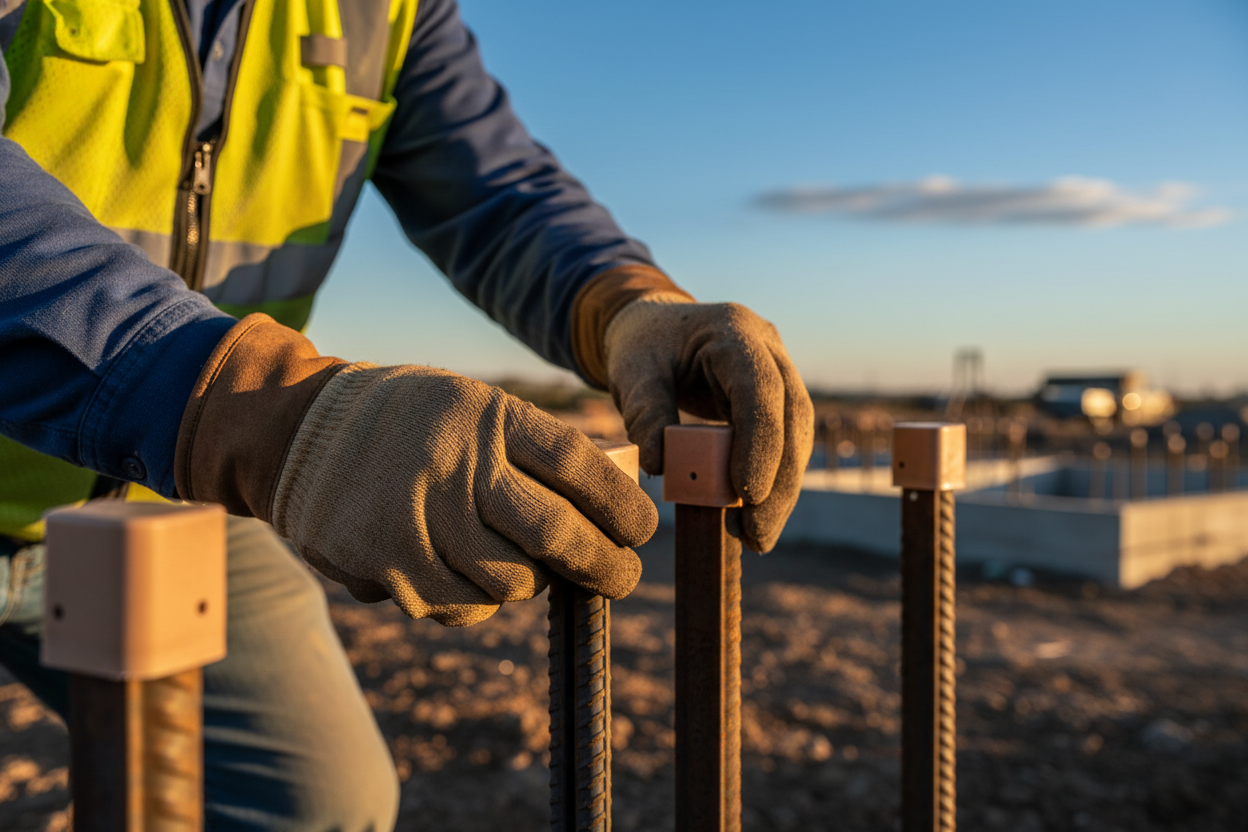The True Cost of Green Building Certifications: Why Construction's 'Small' Materials Create Big Compliance Wins

A tier-one contractor is 92% toward LEED Gold on a $180 million project. Solar arrays, advanced HVAC, low-VOC finishes—everything checks out. Then, three months before final review, they discover their waste diversion rate: 73%. They need 75%. The gap? 2,400 pounds of construction debris nobody thought to track.
Sound like a compliance nightmare? It is. But here's what most people miss: the materials that seem too insignificant to worry about often hold the key to closing certification gaps—and they can do it for pennies on the dollar compared to what's at risk.
Green building certifications like LEED (Leadership in Energy and Environmental Design) and BREEAM (Building Research Establishment Environmental Assessment Method) have transformed how the construction industry thinks about environmental impact. Yet a curious pattern emerges when projects fall short: it's rarely the headline-grabbing features that trip them up. It's the thousands of rebar caps left on-site, the temporary protection materials, the fasteners and clips that never make it into a waste manifest. The industry calls them "incidentals." Certification auditors call them "unaccounted waste." And increasingly, savvy contractors are calling them "opportunities."
The waste diversion paradox that's costing projects millions
Here's what the data actually shows about green building success rates—and it's not what the marketing brochures suggest. According to the U.S. Green Building Council's 2024 impact report, while overall LEED project registrations continue to climb, only 64% of projects that register for LEED certification actually achieve it. Even more telling: waste management prerequisites account for roughly 18-22% of failed certification attempts.
LEED v4.1's construction waste credit requires diverting at least 50% of total construction and demolition debris from landfills, with additional points available at 75% and 90% diversion thresholds. BREEAM uses similar benchmarks, awarding credits based on tonnage diverted and responsible disposal documentation. Both systems sound straightforward on paper. Track your waste streams, separate materials, hit your percentage targets, collect your points.
The reality on active jobsites tells a different story. Major waste streams—concrete, steel, lumber—are relatively easy to capture because they're managed by specialty subcontractors with existing recycling relationships. The challenge emerges in what the industry calls "contaminated" or "mixed" waste: the job-site debris that combines multiple material types, often with soil or other organic matter. These mixed loads typically can't be recycled through conventional channels, and they're surprisingly heavy contributors to overall waste weight.
Enter the small-format items. Rebar safety caps are mandated wherever exposed rebar presents an impalement hazard, yet most are manufactured from polypropylene or polyethylene that gets swept into mixed waste streams at the end of a pour. Temporary protective covers, cable ties, corner guards, and formwork accessories follow the same pattern: individually insignificant, collectively substantial, and almost universally landfilled. A 2023 analysis by the Construction Industry Research and Information Association (CIRIA) found that these "micro-plastics and small-format disposables" represent 3-7% of construction waste by weight—but because they contaminate other recyclable streams, they effectively remove 12-18% of potential diversion weight from eligibility.
That matters enormously when you're trying to hit a 75% diversion rate and you're sitting at 73%.
Why a twenty-cent material swap can protect a five-figure investment
Green building certification isn't just about environmental credentials—it's an economic calculation with surprisingly tight margins. LEED certification costs vary by project size and rating system, but typical fees include registration ($1,200-$6,000), certification review ($3,000-$35,000), and consultant support (often $50,000-$150,000 for complex commercial projects). That's before factoring in the premium costs of green materials and systems.
Here's where the math gets interesting. The financial benefit of certification dramatically outweighs these costs for most developers. A 2023 study published in the Journal of Sustainable Real Estate found that LEED-certified commercial buildings commanded rental premiums of 5-8% and had occupancy rates 4-6 percentage points higher than non-certified equivalents. For a 100,000-square-foot office building at $35/square foot annual rent, that 5% premium translates to roughly $175,000 in additional annual revenue. Over a typical 10-year hold period, we're talking about $1.75 million in incremental value.
Now consider what happens when a project fails certification due to waste diversion shortfalls. The developer has already invested in all the systems and documentation required—the costs are sunk—but they realize none of the market premium. They may attempt re-certification after implementing corrective measures, but that process can add 6-12 months and $40,000-$80,000 in additional fees and consultant time. During that delay, they're marketing and leasing an "almost LEED" building that commands conventional rates.
This is where material specification starts looking like risk management instead of procurement. Let's use rebar caps as a concrete example. A typical large commercial project might use 15,000-25,000 safety caps over the course of foundation and structural work. Conventional polypropylene caps cost approximately $0.12-$0.18 each in bulk. A home-compostable alternative might cost $0.18-$0.25 each—a premium of roughly $0.07 per unit, or $1,050-$1,750 for the entire project.
That $1,500 investment buys you approximately 450 pounds of material that can now be documented as "diverted through on-site composting" rather than "landfilled as contaminated mixed waste." On a project with 350,000 pounds of total construction waste, that's an immediate 0.13 percentage point boost to your diversion rate. It also prevents those caps from contaminating approximately 2,000 pounds of otherwise-recyclable plastic sheeting and lumber scraps that often get mixed in the same waste stream.
The cost of that waste diversion improvement? About $0.000009 per square foot of building space. The cost of missing your certification target? Somewhere between $175,000 and $2 million in lost value, depending on asset class and holding strategy.
Suddenly that twenty-cent rebar cap starts looking like the best insurance policy nobody thought to buy
How specification-driven contractors are rewriting procurement standards
Something quietly transformative is happening in how tier-one contractors approach green building compliance—and it's not coming from sustainability consultants or architecture firms. It's coming from the project managers and site supervisors who've watched too many projects scramble in month eleven of a twelve-month schedule.
The traditional approach to LEED waste management treated diversion as a post-construction accounting exercise: track what you generate, maximize recycling at the back end, hope the numbers work out. Progressive contractors are flipping that model, treating waste diversion as a design input that gets specified at the beginning of the project timeline. The shift is subtle but profound: instead of asking "how do we dispose of this material responsibly?" they're asking "what if we specified materials that don't create disposal problems in the first place?"
Companies like Acciona, Turner Construction, and Fulton Hogan are pioneering what's being called "specification-driven compliance": the practice of pre-qualifying suppliers and materials not just on performance and cost, but on their end-of-life documentation trails. When a material can be diverted through on-site processing—composting, for example—rather than requiring hauling to a specialty recycling facility, it dramatically simplifies the compliance documentation burden.
This matters more than it might seem. LEED and BREEAM both require detailed waste tracking, including material type, weight, diversion method, and receiving facility documentation. Every waste hauling ticket becomes a data point that needs validation. Materials that can be managed on-site reduce the number of third-party waste receipts that need to be collected, verified, and submitted. One contractor described it as "turning a documentation nightmare into a specification checkbox."
There's a network effect at play too. When a tier-one general contractor pre-qualifies a compostable rebar cap or plant-based cable tie for use across their projects, that specification typically flows down to their subcontractor networks. A formwork sub working for multiple GCs will often standardize on materials that are pre-approved across their client base rather than maintaining separate inventories. The result is a specification cascade: one decision by a major contractor can shift purchasing patterns across dozens of subcontractors and hundreds of projects.
The competitive advantage is becoming tangible. Contractors who can demonstrate higher baseline waste diversion rates are increasingly winning bids for public projects and private developments with aggressive sustainability targets. New Zealand's Auckland Council and major retirement village developer Summerset have both begun issuing RFPs that explicitly favor contractors with documented histories of exceeding LEED waste diversion thresholds. In that environment, the contractor who specifies better materials isn't paying a premium—they're investing in competitive differentiation that wins them contracts.
The infrastructure gap that makes good intentions expensive
Specification-driven compliance solves the planning problem—but it exposes another challenge that's harder to engineer around: the waste infrastructure simply isn't there yet.
Even with perfect material choices and meticulous planning, green building projects run headlong into a systemic problem: the waste management infrastructure wasn't built for these materials. Industrial composting facilities that can process bioplastics exist, but they're geographically concentrated and their intake protocols vary wildly. A construction site in Portland might have three certified composting facilities within 50 miles; the same project in Phoenix might have zero.
This creates a perverse outcome where the "right" material choice can actually increase project costs and complications. Compostable materials that require industrial processing need to be segregated on-site, hauled separately, and delivered to facilities that may charge premium tipping fees compared to conventional waste disposal. For projects in regions without accessible composting infrastructure, specifiers face an impossible choice: use conventional materials you know will be landfilled, or use compostable materials that... will also probably be landfilled because there's nowhere to process them.
The regulatory environment compounds the challenge. While LEED and BREEAM provide frameworks for waste diversion, they don't address the practical reality that "divertable" and "actually diverted" are two different things. A material might meet every technical standard for compostability, but if the project site is 200 miles from the nearest certified composting facility, the economics of hauling usually mean it ends up in a landfill anyway. Current green building standards award points based on where materials could theoretically go, not where they realistically will go given local infrastructure constraints.
There's also a certification literacy gap. Many site supervisors and waste coordinators aren't familiar with distinctions between home-compostable, industrial-compostable, and soil-biodegradable certifications. They see a product labeled "compostable" and assume it belongs in the same waste stream as food scraps from the job trailer. Without clear guidance and training, well-intentioned material substitutions can create contamination problems that actually reduce overall diversion rates.
Building toward solutions that scale with real projects
Here's the hopeful part: we're watching the construction industry figure this out in real time, and the solutions are surprisingly practical. The key insight is that the highest-leverage opportunities sit at the intersection of three factors: materials that are used in high volumes, have straightforward end-of-life pathways, and align with existing site management practices.
Home-compostable materials check all three boxes. Unlike industrial compostables that require specialized facilities, home-compostable products are certified to break down in backyard compost piles—which means they also break down when left in contact with soil and moisture on an active construction site. For materials like rebar caps, temporary fasteners, or erosion control products, this opens a remarkably simple compliance pathway: leave them where they fall, document their biodegradation, count them as diverted.
It sounds almost too simple, but it's backed by third-party certification standards. Products certified to OK Compost HOME (EN 13432/14995) or ASTM D6400 with home-compost validation have been tested to ensure they biodegrade in ambient soil conditions without leaving microplastics or toxic residues. For compliance documentation, these certifications provide the same verification trail as a recycling receipt—arguably better, because there's no risk of rejected loads or facility processing issues.
The most sophisticated implementations are combining material substitutions with site management protocols. Several major contractors now incorporate "diversion zones" into their site logistics plans: designated areas where compostable materials can accumulate with soil and organic matter, with periodic documentation of degradation progress. These zones serve double duty as erosion control berms or landscaping preparation areas, turning waste management into productive site preparation.
Cost structures are aligning too. As production volumes increase, the premium for genuinely compostable materials is narrowing—particularly for simple injection-molded items like caps, clips, and covers. The "green premium" that once ranged from 40-60% has compressed to 15-30% for high-volume categories, and that's before factoring in avoided hauling costs and certification risk reduction.
These materials integrate into existing injection molding production lines without requiring retooling, which means manufacturers can produce them at volumes and price points that make specification decisions straightforward. When tier-one contractors like Acciona, Fulton Hogan, and Dominion Construction adopt these materials across their projects, they're not making aspirational sustainability gestures—they're implementing practical risk management that closes certification gaps while simplifying compliance documentation. At Compostify, that's exactly the transition we're working to accelerate.
The broader point isn't about any one company or product. It's that real solutions exist right now that let contractors specify their way out of the waste diversion paradox instead of scrambling to document their way out at the end of a project timeline. When a $0.20 material choice can de-risk a $180 million certification process, that's not a sustainability premium—that's just smart building.
The construction industry built the modern world with materials that were never designed to disappear. We're now in the early stages of rebuilding that same industry with materials that were. The projects getting it right aren't waiting for perfect infrastructure or regulatory clarity—they're specifying better materials today and letting the compliance benefits follow. That's how incremental decisions compound into systematic change: one rebar cap, one procurement policy, one certification success at a time.

